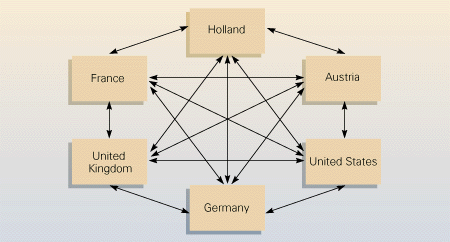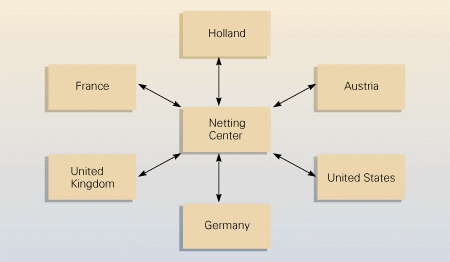Texts belong to their owners and are placed on a site for acquaintance.
Closing Case
A multinational corporation with operating companies in more than 80 countries and sales in excess of $23 billion, Motorola is one of the world's leading providers of wireless communications equipment, semiconductors, and advanced electronics systems and services. Separate Motorola companies act autonomously and trade with each other on an arm's-length basis, often across national borders. Historically, each operating company managed its own payments with other Motorola subsidiaries and with independent suppliers and executed its own foreign exchange dealings. By the mid-1990s, however, Motorola had built a global cash management system that not only managed transactions between Motorola operating companies, but also between Motorola companies and key suppliers.
The evolution of Motorola's global cash management system dates to 1976 when the company decided to develop a foreign currency netting system for transactions between Motorola companies. The objective of this system was to achieve cost savings by reducing both cash flows and the amount of foreign exchange deals required to execute cross-border payments. Under this system, all foreign currency transactions between Motorola companies are managed with a single payment or invoice from a London-based treasury management center to each Motorola company once every week. Figures C.1, C.2, and C.3 show how this system reduces organizational complexity, while the follow ing table gives a numerical example using the exchange rates detailed in Figure C3.
Using the table, the net payments for each operating company can be easily calculated. Specifically,
Company A ( £550 - £50 = £500).
Company B ($100 - $140 = - $40).
Company C (¥10,000 - ¥125,000 = - ¥115,000).
Company D (Kr200 - Kr400 = - Kr200).
Before netting, the total amount of cash flows was the sum of all payments, which in dollar terms amounted to $1,320. The netted cash for each company is the sum of its payables less the sum of its receivables. In local currency, company A will receive £500, B will pay $40, C will pay ¥115,000, and D will pay Kr200. The netted cash flow in dollars is now $1,000. The center receives three different types of currencies, makes one payment to company A, and has a neutral cash position.
The benefits of this system are a reduction in cash flows and in the volume of foreign exchange dealings. Moving from localized treasury management to one centralized system realized an estimated annual financial saving from lower transaction costs (bank fees and foreign exchange commissions) of about $6.5 million. However, this figure does not include administrative
Accounts Receivable
| Accounts | Company A | Company B | Company C | Company D | Total | ||||
| Payable | (£) | ($) | (¥) | (Kr) | Payable | ||||
| Company A | 0 | $100 | 0 | 0 | |||||
| Company B | £50 | 0 | 0 | Kr200 | $140 | ||||
| Company C | £500 | 0 | 0 | 0 | ¥125,000 | ||||
| Company D | 0 | 0 | ¥10,000 | 0 | Kr400 | ||||
| Total receivable | £550 | $100 | ¥10,000 | Kr200 | |||||
Figure C.1
Prenetting Information Flows

Figure C.2
Postnetting Information Flows

Figure C.3
Schematic Model of Currency Netting

gains from more streamlined operations, which while more difficult to quantify, are also probably quite substantial.
Motorola's success at implementing this system is attributed to a number of factors. First, senior management had the foresight to become committed to this initiative at a very early stage. Management saw the system, and the information technology systems required to support it, as a source of strategic advantage. This was helpful in overcoming the normal resistance of operating managers to changes that take away some of their autonomy. Second, Motorola had already made substantial investments in building an information technology backbone to share manufacturing and logistics data between operating companies. Once this system was built, it could easily be extended to incorporate the data required for global treasury management. Third, Motorola took a gradual approach to implementing the system, which helped the company to perfect it before implementing it organizationwide. A few sites were chosen as prototypes. After they had been integrated into the system and operating difficulties had been overcome, the inclusion of other sites proceeded smoothly. As a result, the number of participating Motorola entities rose from 38 in 1983 to 106 by the early 1990s.
Once the internal cash management system was working smoothly, Motorola extended the system to embrace key suppliers and customers. Extending the system was in principle relatively straightforward. Each week, the Motorola netting center collects data from each Motorola entity detailing payments that have to be made to suppliers. The global treasury function executes the required foreign exchange transactions, initiates payment orders, and advises Motorola companies of their net positions. After netting incoming payments with outgoing payments and combining common currencies, an approximate foreign exchange position is reached in which surplus currencies are sold and deficit currencies are purchased. The transaction value is approximately $100 million per week.
These payments are all handled by Citibank, which uses its own global information systems network to transfer funds between the various entities involved in the Motorola system, whether they are Motorola companies or independent vendors. Making this system work requires close electronic links between Motorola and Citibank, compatible information systems, a shared vision as to the purpose of the system, and ongoing cooperation between Motorola and Citibank to improve and manage the global flow of money.
As a result of this system, the net cash flow in 1991 between Motorola operating companies was $2.4 billion, a reduction of $2.38 billion from the value of payments settled in 1991. Without netting, Motorola would have had to engage in foreign exchange transactions valued at $4.3 billion. With netting, foreign exchange transactions were reduced to about $1.3 billion, which equates to annual direct savings in transaction costs of around $6.5 million.
Source: C. P. Holland, G. Lockett, J.-M. Richard, and I. Blackman, "The Evolution of a Global Cash Management System," Sloan Management Review, Fall 1994, pp. 37 - 47, and B. Ettorre, "How Motorola Closes Its Books in Two Days," Management Review, March 1995, pp. 84 - 89.
Case Discussion Questions
- What are the strategic benefits to Motorola of the global
cash management system described in this case?
- How important is the relationship between Citibank and
Motorola to the development, implementation, and smooth functioning
of this system?
- What factors helped Motorola to implement this system in a company where treasury operations had been decentralized to various national operations?